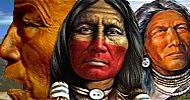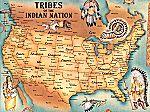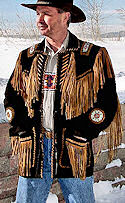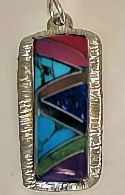| Apache Chastity and Marriage |
 |
 |
|
|
|
||
| N'de, Dinė, Tinde, Inde or "The People" |
| |
Apache Chastity and Marriage |
Artifact Replicas|Jewelry|Clothing|Figurines|On Sale|New ProductsApache Chastity and MarriageFrom Life among the Apaches as observed by John C. Cremony, ca. 1862 Apache ChastityAmong those who have enjoyed the best opportunities for judging, the award for female chastity is given to the Apaches. During a period of about two years, when hundreds of them were under our charge, and mingling freely with our troops, not a single case occurred, to the best of my knowledge, wherin an Apache woman surrendered her person to any man outside her tribe. Cases of conjugal infidelity are extremely rare among them, and the girls take no ordinary pride in guarding their purity. The art of coquetry is practiced among them with quite as much zest as among the belles of our cities, and with such delicacy and tact, that the most refined among us might possibly study at a worse school. On the other hand, the Navajo are extremely loose and sensuous. Although of the main branch of the great Apache tree, the Navajo differ in tribal organization, in their manufacture of superb blankets, in their courage and address, and in the fact that they keep large flocks of sheep and cultivate the earth. In all other respects they are pure Apaches. Female virtue is little regarded among them, but is deemed of primary importance among the Apaches proper. Apache girls were eligible for marriage when they reached the second year of pubertyWhen an Apache girl has reached the second year of her puberty the fact is widely circulated, and all present are invited to a grand feast and dance. She is then deemed marriageable and open to the solicitations of the young warriors. On such occasions the girl is dressed in all her finery. Small bells are hung to the skirts of her buckskin robe and along the sides of her high moccasins, which reach the knee. Bits of tinsel are profusely scattered all over her attire, until she is fairly weighed down by the quantity of her ornaments. Meat in abundance is cooked after their fashion, and the guests partake of it ad libitum. Twilt-kah-yee, an intoxicating beverage is freely distributed. A dried ox-hide is laid upon the ground, and some of the more noted musicians entertain the company with improvised songs, while others beat time upon the ox-hide with long and tough sticks. The noise of this drumming can be heard for two miles on a clear, calm night. Old warriors meet and recount their exploits; young ones ogle and court the marriageable girls; old women delight in cooking the supper and furnishing it to their hungry applicants. Suddenly a shout is raised, and a number of young men, variously attired in the skins of buffalo, deer, cougars, bears, and other beasts, each looking as nearly natural as possible, make their appearance, and commence dancing to a regular measure around a huge central fire. The women pretend to be greatly alarmed at this irruption of beasts; the men seize their weapons and brandish them with menacing gestures, to which the human menagerie pays no sort of attention. Finding their efforts to intimidate futile, they lay aside their arms and join in the dance, which is then made more enjoyable by the intermingling of the young girls. The Apache bride to be does not participate in the celebrationIn the meantime the one in whose honor all these rejoicings are given, remains isolated in a huge lodge, in which are assembled the sagamores and principal warriors of the tribe. She is not allowed to participate in, or even see what is going on outside; but listens patiently to the responsibilities of her marriageable condition. This feast lasts from three to five days, according to the wealth of the girl's father. The Apache woman plucked all her eyebrows to announce her availability for marriage.After it is finished she is divested of her eyebrows, which is intended to publish the fact that she is in the matrimonial market. A month afterward the eyelashes are pulled out, one by one, until not a hair remains. The reasons for this extraordinary despoliation I have never been able to learn, and I doubt much if the Apaches themselves can assign any cause to the act beyond the exactions of custom. But this system of depilorizing the brows and eyes is not confined to the women; it is universal among the warriors, nor could any arguments of mine induce them to forego the practice. It probably arose from a desire to look unlike any other people, and to add to their ferociousness of aspect. Apache marriage customsMarriage among the Apaches also has its singularities, and is not unworthy of special mention. The girls are wholly free in their choice of husbands. Parents never attempt to impose suitors upon their acceptance, and the natural coquetry of the sought-for bride is allowed full scope. These are their halcyon days, for after marriage "comes the deluge." Any amount of ogling, sly pressing of hands, stolen interviews, etc., is gone through with, just the same as with us, until the suitor believes his "game made," when he proceeds to test his actual standing, which is invariably done as follows: In the night time he stakes his horse in front of her roost, house, hovel, encampment, bivouac, or whatever a few slender branches, with their butt ends in the ground and their tops bound together, may be termed. The lover then retires and awaits the issue. Should the girl favor the suitor, his horse is taken by her, led to water, fed, and secured in front of his lodge; but should she decline the proffered honor, she will pay no attention to the suffering steed. Four days comprise the term allowed her for an answer in the manner related. A ready acceptance is apt to be criticised with some severity, while a tardy one is regarded as the extreme of coquetry. Scarcely any of them will lead the horse to water before the second day, as a hasty performance of that act would indicate an unusual desire to be married; nor will any suffer the fourth day to arrive without furnishing the poor animal with its requisite food and drink, provided they intend to accept the suitor, for such a course would render them liable to the charge of excessive vanity. With us the possession of gold and silver indicates the enjoyment of wealth. Gold and silver are the recognized mediums of exchange for goods, and are called money; but with the Apaches a horse is money, and the value of any article is regulated by the number of horses which it may bring. Of course, the animal must be sound, and not over ten years of age, and no farrier among us is more skillful in these matters than they. The lover, having been accepted, it becomes his duty to determine how many horses her parents are willing to receive for their daughter, it being mutually understood that the animals are given as a recompense for her services to the family. In exact proportion to the number of horses given, her worth and attractiveness are exalted. If a girl is sold for one animal, no matter how good, she is deemed of little account--quite plebeian, and by no means of the bon ton--by the rest of those present, and I am not so sure that our expression, "a one-horse affair," did not take its rise from this Apache system of graduated values. The Apache WeddingOn the third night of the feastings and junketings incident to the marriage, the bride and bridegroom suddenly disappear. During the whole of the time mentioned, they have been constantly in the presence of the sachems and wise women of the tribe, and are never permitted to even speak with each other. But love is far more watchful than precaution, and when the old people are overcome by drowsiness, incident upon long wakefulness and frequent potations, the young couple manage to make their escape, usually with the connivance of their seniors, who pretend to be quite innocent of the matter. Apache preparations for the weddingSeveral days prior to his marriage, the bridegroom selects some beautiful and retired spot, from three to five miles from the main camp, and there he erects one of the shelters already described, but festooned with wild flowers, and generally embowered among the trees in a place difficult to discover. There he retreats with his bride, a sufficiency of provision having been laid in to last them a week or ten days, and there they take up their temporary abode. Their absence is expected, and re-appearance creates no visible recognition, as it is deemed indelicate to make any open demonstration on such occasions. The young bride assumes the air and pretenses of extraordinary modesty, and in the event of meeting one of her former associates, invariably turns her back or hides her face, and puts on all the simper of an American girl of twenty years ago--not nowadays--when accused of having a lover. In a week this seeming bashfulness gives place to the regular and arduous duties of the Apache wife, and her life of toil and slavish suffering commences. Apache divorces and remarriageThe warrior may at any time repudiate his conjugal companion, and her chances for a second marriage consist in her reputation as a good worker, or for her personal attractions. In either case, she experiences no difficulty in obtaining a second, and even a third or fourth husband, but her market depends upon her prominence in these respects. Should there be any children, it becomes the reputed father's duty to provide for their support, and he, in turn, imposes that responsibility upon his other wives. The women are by no means averse to sharing the affections of their lords with other wives, as the increased number lessens the work for each individual, but the place of honor is always assigned to the one who was the first married, irrespective of age. Apache polygamyThe custom of polygamy was not always in vogue among the Apaches. A celebrated warrior, and one wise in the traditions of his people, told me that the time was when only one woman was deemed the proper share of one man, but their losses by war, and other causes, had so reduced the number of males that it was judged politic to make a change in this custom. He further added, that he thought degeneracy had been produced by its adoption, and that the individuals of the tribe had become alienated from each other. He rejoiced in but one wife with whom he had lived twenty years, and although she had fallen into the "sere and yellow leaf," he preferred her to all the young and more attractive women. She had borne him two fine sons and a daughter, all of whom were alive and well, and she possessed the experience requisite to make him a contented husband. His oldest son was a warrior, and his father's best friend and associate. He deprecated the system of polygamy, and thought that it would eventually emasculate and destroy the independence of his tribe. This was Nah-tanh, and his views were fully seconded by Klo-sen, and several others, but they could not hold their own against the practices of Gian-nah-tah, Natch-in-ilk-kisn, and other prominent and more licentious men. 
Loss Art Print Buy at AllPosters.com Framed Mounted |
What's New in the Gallery Store: Native American Tribes by States Poster  25 new fringed leather jackets  Zuni Style inlaid stone jewelry More New Products |
||||||||||||||||||||||||||||||||||||||||||||||||||||||||||||
Apache chastity and marriage Apache customs regarding courtship, marriage and divorce. Wives and burial place of Geronimo A detailed list of all the wives of Gernonimo and his burial place. Why do we yell "Geronimo"? Learn the legend behind this phrase. Apache tribal amusements, manners, and customs As explained by Geronimo in the telling of his life story.
| |
| Back to Top |Shipping & Return Policies |Customer Testimonials |Site Map |Affiliate Program |Privacy Policy |Contact Us | Submissions |